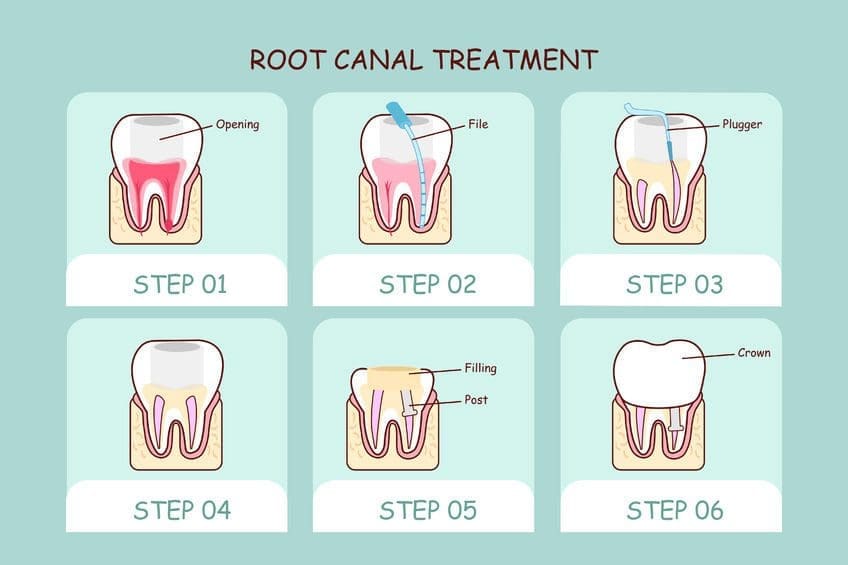Root canal treatment is a dental procedure in which the tooth pulp is removed because it is either infected or rotten. The pulp consists of nerves, connective tissues and blood vessels. There are various reasons for rotting of the pulp, untreated cavities, injury to the tooth, and different procedures previously performed on the same tooth.
Symptoms of rotting pulp include a warm sensation, pain and swelling in gums, bleeding gums, etc. Removing the pulp is the best choice to preserve the tooth structure and shape, saving the patient from the hassle of tooth extraction.
The root canal procedure
This procedure is carried out under local anesthesia. Normally a dentist or endodontic performs the root canal procedure. Before the procedure, the dentist may recommend getting an X-ray of your teeth to examine the diseased tooth better. The root canal procedure takes place in the following manner.
1. Anesthetic injection
To lessen the pain of this procedure, an anesthetic is administered. This numbs the area surrounding the rotten pulp. Anesthesia is either injected or applied on the pulp directly. The patient remains awake during the procedure and feels minimal pain. In some dental clinics unconscious sedation is also available in which the patient can sleep during the procedure. However, most people chose to remain awake during the treatment because of minimal pain experienced.
2. Dental dam insertion
A dental dam is a sheet of rubber like material. Latex and sometimes nitrile is used to separate the area of procedure from the rest of the mouth. A small hole is created in the dam for dental instruments to reach inside the mouth. The dam is held in place by clamps on either side. This will help the dentist visualize the tooth and help concentrate better. It also reduces the risk of infection and contamination in the rest of the mouth. The dam is removed after the dead pulp is cleaned away.
3. Drilling and removing the pulp
To remove the pulp, a small hole is made on the surface of the tooth with the help of a dental drill. Once the opening is created successfully, a dental equipment called file is used to remove the rotten pulp from inside the tooth. The length of the tooth has to be measured to use the correct file. It is made of metal. The procedure will be painless because of the previously administered anesthesia and modern technology has also made it possible for this to be a painless procedure. Drills are also used but it shouldn’t make you nervous about the procedure as today’s dental drills are designed to deliver maximum effectiveness with minimal pain. Finally on reaching the pulp chamber, the pulp is removed using specialized equipments.
4. Cleaning and disinfecting
An antiseptic and antibacterial solution is applied to the area of operation. This helps to prevent bacteria growth and removes the risk of further contamination. Sodium hypochlorite or water is used to clean the remaining bacteria. Debris and plaque are cleaned this way. This ensures no microbes grow inside the pulp chamber even after it is packed with the filling and sealant.
5. Shaping canals
Before filling the cavity with the temporary filling, space must be created in the tooth. Therefore, the gap is enlarged. This is done with the help of specialized miniature dental tools. The teeth are cleaned yet again and then filled. The widened canals also help in flowing the cleansing fluids easily and result in better disinfection of the tooth.
6. Temporary filling
An antibiotic is applied in the canals to ensure the infection doesn’t return. After cleaning properly, the cavity is refilled with a special type of filling called gutta-percha and a sealing paste. Both these fillings help prevent the tooth from getting re-infected. The pulp chamber is completely filled and no space is left, so as to prevent microbial and bacterial growth. Gutta-percha is also antibacterial in nature and will not promote any further infection. It is heated first and compressed then filled into the cavity. It is very important to use a sealant over the filling to prevent microbial growth. The dental dam is removed and the procedure ends here. A crown may or may not be placed depending on the condition of the tooth.
7. Antibiotics
Some discomfort should be expected a few days after the procedure. After the treatment, you may be recommended some antibiotics like ibuprofen or Advil. Do not take any medications by your own, always ask your dentist or the doctor first. You may also be advised to not eat from the side of the tooth under operation. Improper use of medication can lead to various hazards. Also, if you are allergic to any specific medications, let your dentist know. This will result in proper treatment, quick healing and no mishaps.
8. Crown placement
The lack of pulp often makes the tooth fragile and uncomfortable. In such situations, the dentist will recommend placing a crown over the tooth. It is placed if the root canal treatment is done on the back tooth and the damage to the tooth is too severe. The crown is placed for providing strength to the tooth. The temporary filling has to be removed for crown placement. This step often takes place in a separate visit. The crown also helps in protection of tooth from bacterial attack.
Root canal treatments are rumored to be painful and scary, but thanks to modern techniques, the treatment has become bearable. The treatment is worth it as after the root canal, the tooth remains in good condition for the rest of the life. There may be some discoloration but if you take care of your teeth such a situation may never arrive.
It is also essential that you avoid eating hard, crispy and spicy foods as they will hinder the recovery of your tooth. Brush your teeth as per your daily routine. Now that you know what exactly happens during a root canal treatment, you can receive the procedure without fear.

